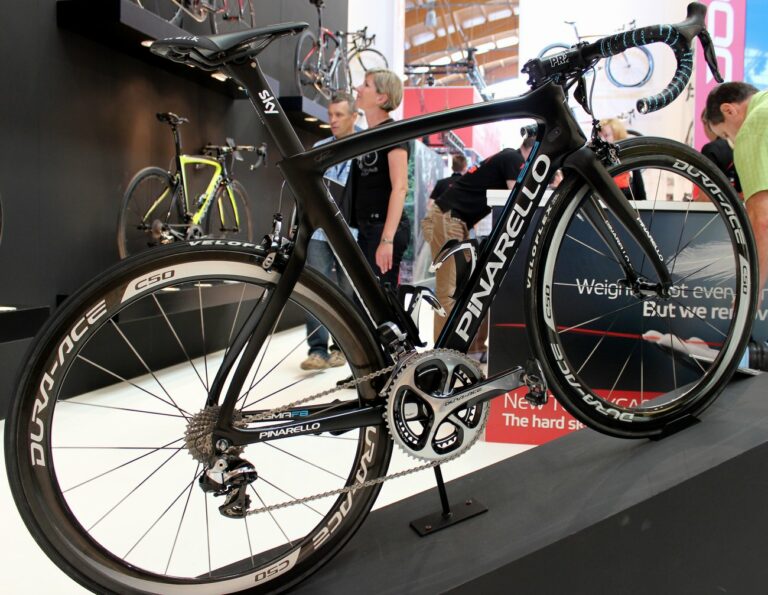Canyon has unveiled its latest concept bike for Eurobike – the MRSC, billed as a ‘connected’ bike.
The German brand, which has already released three new road models this season – the Endurace CF and AL, and the Aeroad CF SLX – has pulled back the covers from a road bike with an active suspension system front and rear, and a series of sensors controlled from a ‘brain’ designed by T-Mobile owners, Deutsche Telekom, compatible with i-Phone and Android smartphone platforms.
Dr Michael Kaiser, head of R&D at Canyon Bikes, told journalists that the company was focused on helping its customers to ride faster, safer, and more comfortably. “The project bike this year is a road bike and we see huge potential in suspension and communication,” he said.
Held in suspense
With stiffness the principal goal for most performance road bikes, the introduction of suspension to a machine intended for speed, and built around Canyon’s ‘Pro’ geometry (“long, low, and aerodynamic”), seems counter-intuitive. However, Sebastian Wegerle, Canyon’s lead engineer on the MRSC project, argued that comfort was essential to achieving speed. “Our focus is always to make the bike faster, and your body has to do less work if you have a comfortable bike frame. Bumps from the road make the system slower, so it is really about building a faster bike,” he said.
Canyon tested the MRSC back-to-back with a 2010 Ultimate CF on a “fixed test route that included several rough sections” and claims that its active suspension system “drastically minmised” lateral and horizontal movement. The benefit to the rider, they claim, will be registered in energy savings otherwise lost to coping with road vibration.
The viscosity of the damping fluid that controls the suspension is raised (made thicker) or reduced (thinned) by the polarisation of metal particles suspended within in it. This polarisation is activated by sensors that instruct the MR bearings which control carbon leaf springs – one at the end of each fork leg, attached to the dropout, and another connecting the seat-tube to the rear triangle – to exert a magnetic field. The system offers 15mm of suspension travel, sufficient, say Canyon, “for around 90 per cent of riding scenarios encountered on the road”.
“Whenever you apply a magnetic field, you change the viscosity of the fluid,” Wegerle said. “By changing the viscosity of the fluid, you can control the damping, and have a lock out mechanism.” The lock out mechanism can also be activated manually, with a push button located in the ‘drop’ of the handlebar, in an interface similar to Shimano’s Di2 ‘sprinter switches’.
The use of an electro magnetic field to control the damping of a suspension system is a further step along a road in which electronics have increasingly become part of the modern bicycle, with Shimano Di2 and Campagnolo EPS transmissions, and GPS systems such as Garmin’s Edge computer, now standard fare. “Electronics are becoming more and more popular on bikes,” Wegerle said. “In the future, probably every bike will have a battery integrated.”
Get connected
Canyon has worked with Deutsche Telekom to develop the ‘connected’ part of the project. Thomas Eckert, a senior engineer with the communications giant, whose day job involves developing communication systems with motor manufacturers like BMW and Mercedes, told RCUK that work to design the project bike’s ‘brain’ had begun just six weeks ago.
An onboard control unit located in the triangular section connecting the top of the seat-tube with the underside of the top-tube contains a GSM module with its own SIM card, a GPS device that plots the location of the bike, and a host of sensors that serve as sophisticated wear indicators for service items such as chain and brake pads. The sensors can send a message to the rider’s smartphone, warning of the need to replace certain parts, and even connect him to an online ordering facility for spares. A video on how to install the replacement part can also be accessed.
Smartphone technology can also be used to trace the bike, and to record performance data. The E-Call function sends a message to the rider’s smartphone when sensors detect crash damage, or, to put it another way, when he might have been involved in an accident. “If he doesn’t react in a defined time, then the bike will send an E-Call to a defined number or to an emergency line,” Eckert said. “With this message, they get the position of the bike – where the accident has happened – and also information about the rider: his name, his contact data, and features like blood type.”
The future?
What might be described as the more ‘conventional’ elements of the project bike are also strikingly modern. The headtube, for example, is identical to the heavily sculpted unit of the Aeroad CF SLX, unveiled just last month in Leeds, days before the Tour de France. The integrated Aerocockpit CF, a one-piece handlebar and stem combination launched at the same time, is also featured.
Designer, Wanjo Koch, told RCUK that the concept machine followed Canyon’s established ‘design language’, one developed by external agency, Artefakt, with whom the bike brand collaborated on the radical Speedmax CF time trial bike, the lightweight Ultimate CF SLX, and most recently, the Aeroad CF SLX.
Other features of the concept bike that might be considered radical by themselves on more conventional road bikes include hydraulic disc brakes (160mm front, 140mm rear) and bolt thru axles (15mm, 12mm). The MR bearings that control the front suspension are located in the front dropouts, and mechanical adjustment can be made with screws located in the rear of each fork leg.
Canyon has no immediate plans to put the MRSC ‘connected’ bike into production, but Kaiser suggested that the ideas could be implemented within the next five to ten years. “Canyon has a long tradition of project bikes,” he said. “In 2004, we started with world’s lightest road bike at 3.7kg. A year later, we presented the first road bike with hydraulic disc brakes. In 2006, we had a time trial machine with integrated brakes and an integrated drinking system in the frame, and a lot of these features I think you can see today.” Watch this space.
Website: Canyon Bikes





